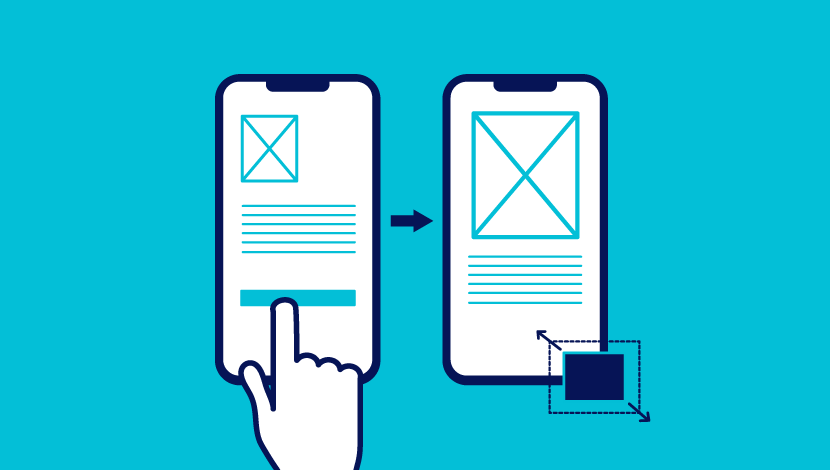
As I was thinking about trends and what they mean and their value, I decided to take a slightly different route. One of Flint’s values, and my personal favorite, is “Do The Right Thing.” Why do people care so much about the latest trends? They want to appear new and current. In the end, when it comes to user experience, it’s less about trends and more about doing the right thing. Here are five tips for user experience to ensure you’re doing the right thing in 2021.
1. Accessibility
Building accessible and WCAG-compliant websites is still a relatively new concept for many of our clients. Being accessible means that people, no matter their abilities, can easily access the information on your website.
When you start thinking about your new website or website refresh, consider accessibility along each stage of the process.
- Architect a clear, easy-to-understand navigation structure.
- Design copy and visual elements that allow for readable font sizing across devices and consider good color contrast.
- Write clear, concise copy with intuitive links. (In other words, don’t make a link say “click here.”)
- Consider all parts of your content, including downloadable files like PDFs and videos. They are part of the website experience and should be accessible as well.
- Your website code should be developed to support the flow of assistance devices – and make sure your meta data is informative.
At Flint we follow the standard WCAG 2.1 AA compliance and the principles known as P.O.U.R. – Perceivable, Operable, Understandable and Robust. We also use PowerMapper to ensure we’re not missing anything. Depending on your industry, there may be legal requirements around accessibility, but in the end, building tools that everyone can use is simply doing the right thing. To learn more about building accessible communications, connect with me and I’ll share a presentation we recently gave on this very topic.
2. Storytelling & Emotion
“Emotions are the way in which our brains encode value. Brands who engage with us emotionally will win every single time.” – Martin Lindstrom, author of “Buyology,” a study of neuromarketing.
You have gone through the efforts necessary to get a customer to your website. How do we respect their time and create value? It doesn’t matter if you’re selling a service or widget, the ability to craft an interesting story around your product will help drive an emotional connection for your brand. There are certainly times when features and benefits are an important part of the story, but that doesn’t mean it has to be boring. Creating interesting, easy-to-understand copy and imagery will add value to the person reading it. And don’t forget about the micro-moments – little things that make a big difference, like help text, form field errors or thank you page text. These are often forgotten elements of copy, but the details matter. In a world where fragmented attention is the norm, pay close attention to the content on your website. Rethink the use of stock photography and the story it’s telling. Read your copy aloud. Look at the site through the lens of your customer to get a fresh perspective. How does it make YOU feel? How about your customer? Are you creating value and driving emotion? If not, try again. Read more about the power of emotion in marketing.
3. Make Yourself Findable
Stop for one moment and reflect on your own website searching habits. It is becoming rarer that people will look for your website by typing in the exact URL. It’s more likely they’re going to ask Siri, Google or Alexa to help find an answer. How can you build your website to be a helpful asset to your customers? What can you do in your content or the backend coding of your site to help people get the answers they are looking for? Are you using structured data markup on your site, also known as Schema? Schema markup on your site helps search engines, including voice search, return information to users within the search engine itself. You can use rich snippets to markup things like your FAQs, event schedules or products. Don’t forget about Google My Business and Facebook. Your customers will often Google your hours, address or phone number instead of going to your website. Make sure it’s updated and matches across all platforms. When it comes to making it easier for people to get information you’re offering, are you doing the right thing?
4. Mobile (Again!)
I feel like mobile gets added to the list every year and it’s a little bit like Groundhog’s Day. The iPhone came out in 2007. We have had 14 years to make sure that websites perform on that little device in your hand. In 2020, mobile generated 50.81% of all global web traffic. But alas, the complexity of the platforms, phone sizes and brand managers that don’t take the time to see how the site performs on multiple mobile devices has created a slew of mobile web experiences that cause frustration, and sometimes the random expletive.
Take this challenge: Think of two to three things your customers may want to find on your website. Visit a busy, dimly lit place and walk around while accessing your website from your phone. People use their phones in imperfect situations in which they’re distracted by other things. When you look at your site, can you complete the top three goals quickly and easily? Are you easy to contact? Is the copy large enough and easy to quickly scan and read? Are your products or services easy to find and understand? Are you doing the right thing when it comes to mobile?
5. More People, Less “Users”
After watching “The Social Network” on Netflix this last winter there was one profound quote that made me stop and think. I’ve decided that 2021 is the year I stop calling people using a website “users.” When your craft is titled User Experience, taking the word “user” out creates creative thinking, and an opportunity to humanize the experience. When we change “users” to people, like “members” or “customers,” the word “experience” is somehow more impactful. Think about creating visual persona boards of your customers. Give them a face and a name to help identify their concerns and worries. Even if they’re not formal “personas,” this exercise will help you and your extended team of designers, writers and developers better understand the reason for building each page in the web experience.
In Closing…
Improving the experience of your digital tools should not be a trend, but instead, be never-ending. With technology advancing at exponential speeds, the trends to watch in experience design are less about what’s hot in the visual design or technology world, and more around ensuring that your tools are following suit with the advancements of technology and that you’re providing experiences to help make the lives of your customers (not users!) easier. Interested in making your digital experiences better? Let us know or connect with me on LinkedIn.
Glossary
User experience: The overall experience of someone using a website, including how easy it is to use and how clear the information is to digest.
WCAG: Web Content Accessibility Guidelines. These help developers and designers create websites that are useful to everyone.
P.O.U.R.: Perceivable, Operable, Understandable and Robust. This method helps developers create technology that is accessible to all.
Schema markup: A code placed on the backend of websites to help it become more detectable by search engines, such as Google.

Jen Halvorson
With her passion of understanding and crafting experiences, Jen works with clients to integrate digital communication strategies into their overall marketing matrix. From defining the usability standards of simple websites to full digital communication plans, Jen defines appropriate solutions to help clients meet their business objectives. With over 20 years of experience, Jen believes that effective interactive work must be relevant and intuitive. She works closely with the entire digital team in architecting and validating cohesive user-focused solutions that work seamlessly into the user’s journey with a brand. She also really enjoys the salted caramel cupcakes from Hy-Vee.
